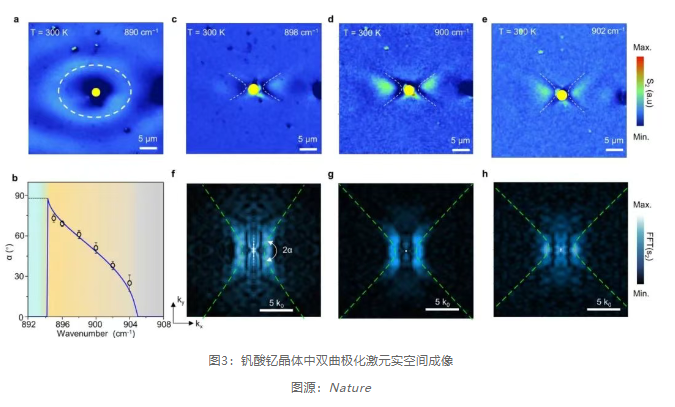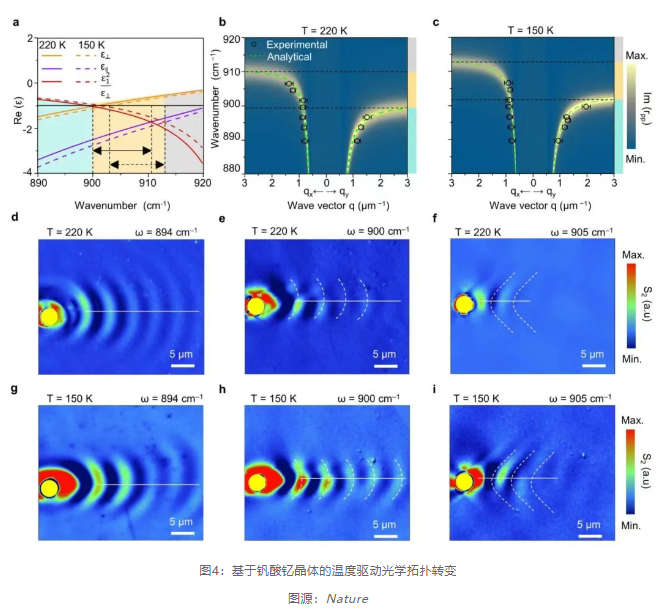17
2025
-
07
Hyperbolic polaritons found in non-hyperbolic materials
Author:
Hyperbolic materials, with their unique electromagnetic properties, are considered one of the core carriers in nanophotonics. However, their optical response is limited to a fixed hyperbolic frequency band, greatly restricting their application potential. A collaborative international team from China University of Geosciences (Wuhan) and Nanyang Technological University, Singapore, for the first time observed hyperbolic phonon polaritons in the non-hyperbolic band (where the dielectric tensor components are all negative) of a YVO4 crystal. 4 Through temperature control, the team achieved an optical topological phase transition of the polaritons from hyperbolic to elliptical type and revealed their low-loss, long-distance propagation characteristics. This discovery breaks the inherent understanding in the field of hyperbolic materials and opens up new pathways for nanophotonic manipulation.
Recently, a collaborative team led by Professor Dai Zhigao from China University of Geosciences (Wuhan) and Dr. Hu Guangwei (Assistant Professor, Nanyang Technological University), Singapore published in the journal “Nature” a research paper titled “Long-range hyperbolic polaritons on a non-hyperbolic crystal surface”. This research, for the first time, observed hyperbolic surface phonon polaritons (hSPhPs) in a non-hyperbolic crystal, breaking the academic community's traditional understanding of hyperbolic wave dependence on “intrinsic hyperbolic materials” and opening up a new research paradigm for hyperbolic polariton nanophotonics.
Hyperbolic polaritons achieve extreme compression of the optical field on the material surface, providing key support for applications such as high-sensitivity sensing and super-resolution imaging. However, existing research relies on artificial hyperbolic metamaterials and natural hyperbolic materials (such as metal-dielectric multilayers, hexagonal boron nitride, molybdenum trioxide, etc., dielectric constant systems with opposite signs), and their hyperbolic characteristics only exist in specific “hyperbolic frequency bands” (Reststrahlen bands). Whether hyperbolic polaritons can be excited in non-hyperbolic materials and in-situ dynamic control can be achieved has become a core challenge in the field.
Research Highlights
The team chose tetragonal YVO4 crystal as the carrier (Figure 2). 4 Experimental results show that even in the non-hyperbolic frequency band where the dielectric tensor components ε ∥ and ε ⊥ are both negative, the material surface can still support the propagation of hyperbolic phonon polaritons.

Key mechanism: Specific surface wave resonance conditions are met at the interface (-ε 1 <ε ⊥ <0 and ε ∥ <ε 1 2 /ε ⊥ <0), which allows the electromagnetic field to propagate only in one direction, exhibiting a hyperbolic equi-frequency contour in the plane.
Experimental verification: Through scattering-type near-field optical microscopy (s-SNOM), hyperbolic wavefronts were directly observed in the 895 – 905 cm -1 frequency band (Figure 3 c-e), and its opening angle α decreases with increasing frequency (898cm -1 when α=51°, 902cm -1 when α=33°).

The research achieved a breakthrough in in-situ dynamic control: By lowering the temperature (300K→150K), the dielectric constant of the YVO4 crystal undergoes a blue shift (Figure 4a), inducing an in-situ optical topological transition of the polaritons from elliptical to hyperbolic.
Phase transition process: At 220K, at 894cm -1 it is an elliptical wavefront (Figure 4d), at 900 cm -1 it transitions to a diffraction-free “collimated mode” (Figure 4e), and at 905 cm -1 it evolves into a hyperbolic wavefront (Figure 4f).
Long-range propagation: At low temperatures, the propagation distance of polaritons is significantly improved. At 150 K, the propagation distance of elliptical polaritons reaches 59μm, and the group velocity is as high as 0.076c. Compared with traditional materials such as α-MoO 3 and hBN, its propagation distance is improved by about an order of magnitude, and the group velocity is improved by nearly two orders of magnitude compared to α-MoO 3 .

This research clarifies that hyperbolic dispersion and hyperbolic crystals are not necessary conditions for achieving hyperbolic polaritons, significantly expanding the application boundaries of hyperbolic nanophotonics. In the non-hyperbolic frequency band of YVO4 crystal, we observed for the first time the existence of hyperbolic phonon polaritons, which exhibit excellent characteristics such as low loss, long propagation distance, and long lifetime. Furthermore, by simply controlling the incident infrared light frequency and ambient temperature, in-situ optical topological transition of hyperbolic phonon polaritons from elliptical dispersion to hyperbolic dispersion can be achieved, eliminating the need for complex micro-nano fabrication processes. In addition, the extended conditions of this hyperbolic polariton and temperature-driven dispersion engineering significantly improve the fine-tuning ability of the polariton wavelength and group velocity, exhibiting high sensitivity and fast response modulation characteristics. This mechanism provides new physical pathways and engineering methods for enhancing light-matter interaction and promoting the development of hyperbolic polariton technology.
It is reported that the first author of this paper is Dr. Liu Lu, a doctoral student of Professor Dai Zhigao, from China University of Geosciences (Wuhan), Dr. Xiong Langlang, Dr. Wang Chongwu, and Dr. Bai Yihua from Nanyang Technological University. The corresponding authors are Professor Li Guogang and Professor Dai Zhigao from China University of Geosciences (Wuhan), Professor Wang Qijie and Professor Hu Guangwei (Assistant Professor, Nanyang Technological University) from Nanyang Technological University. Doctoral student Wang Yupeng from China University of Geosciences (Wuhan), Professor Ma Weiliang from University of Electronic Science and Technology of China, Professor Li Peining from Huazhong University of Science and Technology, and Professor Francisco J. Garcia-Vidal from Autonomous University of Madrid, Spain, made valuable contributions to the publication of this paper. The research work was supported by the National Natural Science Foundation of China, the Singapore National Research Foundation, and other projects. The School of Materials Science and Chemistry, China University of Geosciences (Wuhan), is the first completing unit.
LATEST NEWS
2025-08-20
High-order vortex beams assist super-resolution imaging
Recently, Professor Huang Zhiwei from the Department of Biomedical Engineering at the National University of Singapore led a biophotonics team in a latest study proposing that by introducing higher-order vortex beams into the minimal light flux (MINFLUX) imaging technology, the measurement accuracy of the imaging system can be significantly improved, thereby further breaking through the resolution limits of traditional optical imaging.
2025-08-20
Intrinsic Higher-Order Topological Insulators Based on Equivalent Medium Systems
Recently, Dr. Shaojie Ma, a young researcher at the Fudan University Institute of Future Information Innovation, Professor Lei Zhou from the Department of Physics, and Professor Shuang Zhang from the Department of Physics at the University of Hong Kong collaborated to achieve breakthrough progress in the field of topological state research, proving for the first time at both theoretical and experimental levels that intrinsic higher-order topological insulators (HOTI) exist in uniform electromagnetic media.
2025-08-20
Research on Non-Hermitian Properties Assisted by Orbital Angular Momentum Synthesis Dimensions
In quantum mechanics, observables usually need to satisfy Hermiticity to ensure that their eigenvalues are real numbers.
2025-08-20
Differentiable imaging unlocks full-link optimization
In the field of computational imaging, uncertainty has long constrained technological development.
2025-08-20
Reconfigurable multifunctional integrated optical computing chip
The development of artificial intelligence is driving the evolution of computing architecture towards higher performance, lower power consumption, and greater adaptability.

